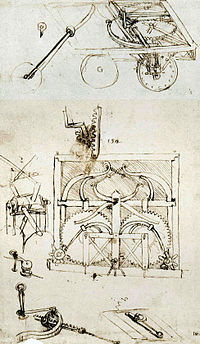
Leonardo's self-propelled cart is an invention designed by Leonardo da Vinci, considered the ancestor of the modern automobile.

Leonardo's self-propelled cart is an invention designed by Leonardo da Vinci, considered the ancestor of the modern automobile.
The machine is powered by two symmetric springs hidden in drum-like casings. While one spring would be enough to move the device, two symmetric springs probably looked like a more "logically perfect" solution. Leonardo had been well aware that the powering force provided by the springs drops significantly when they unwind. In order to deliver smooth and stable motion, the machine features a balance wheel, as used in clocks. The control mechanism is quite complex and allows it to follow a pre-programmed path automatically. The machine also features a mechanism similar to a differential that in addition allows the turning angle to be set.
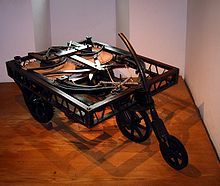
A replica of the self-propelled cart is kept at the museum Clos Lucé, near Château d'Amboise, in France. The television show Doing DaVinci also made a replica in 2009. [2]

Leonardo di ser Piero da Vinci was an Italian polymath of the High Renaissance who was active as a painter, draughtsman, engineer, scientist, theorist, sculptor, and architect. While his fame initially rested on his achievements as a painter, he has also become known for his notebooks, in which he made drawings and notes on a variety of subjects, including anatomy, astronomy, botany, cartography, painting, and paleontology. Leonardo is widely regarded to have been a genius who epitomized the Renaissance humanist ideal, and his collective works comprise a contribution to later generations of artists matched only by that of his younger contemporary Michelangelo.

The Last Supper is a mural painting by the Italian High Renaissance artist Leonardo da Vinci, dated to c. 1495–1498, housed in the refectory of the Convent of Santa Maria delle Grazie in Milan, Italy. The painting represents the scene of the Last Supper of Jesus with the Twelve Apostles, as it is told in the Gospel of John – specifically the moment after Jesus announces that one of his apostles will betray him. Its handling of space, mastery of perspective, treatment of motion and complex display of human emotion has made it one of the Western world's most recognizable paintings and among Leonardo's most celebrated works. Some commentators consider it pivotal in inaugurating the transition into what is now termed the High Renaissance.

Leonardo da Vinci was an Italian Renaissance painter and polymath who achieved legendary fame and iconic status within his own lifetime. His renown primarily rests upon his brilliant achievements as a painter, the Mona Lisa and The Last Supper, being two of the most famous artworks ever created, but also upon his diverse skills as a scientist and inventor. He became so highly valued during his lifetime that the King of France bore him home like a trophy of war, supported him in his old age and, according to legend, cradled his head as he died.

The P 26/40 was an Italian World War II heavy tank. It was armed with a 75 mm gun and an 8 mm Breda machine gun, plus another optional machine gun in an anti-aircraft mount. Design had started in 1940 but very few had been built by the time Italy signed the armistice with the Allies in September 1943 and the few produced afterwards were used by the Germans.
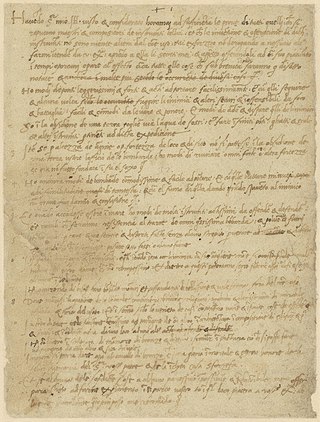
The Italian polymath Leonardo da Vinci (1452–1519) left thousands of pages of writings and drawings, but rarely made any references to his personal life. The resulting uncertainty, combined with mythologized anecdotes from his lifetime, has resulted in much speculation and interest in Leonardo's personal life. Particularly, his personal relationships, philosophy, religion, vegetarianism, left-handedness and appearance.

Renaissance technology was the set of European artifacts and inventions which spread through the Renaissance period, roughly the 14th century through the 16th century. The era is marked by profound technical advancements such as the printing press, linear perspective in drawing, patent law, double shell domes and bastion fortresses. Sketchbooks from artisans of the period give a deep insight into the mechanical technology then known and applied.

Leonardo da Vinci (1452–1519) was an Italian polymath, regarded as the epitome of the "Renaissance Man", displaying skills in numerous diverse areas of study. While most famous for his paintings such as the Mona Lisa and the Last Supper, Leonardo is also renowned in the fields of civil engineering, chemistry, geology, geometry, hydrodynamics, mathematics, mechanical engineering, optics, physics, pyrotechnics, and zoology.

Museo Nazionale Scienza e Tecnologia Leonardo da Vinci in Milan, dedicated to painter and scientist Leonardo da Vinci, is the largest science and technology museum in Italy. It was opened on 15 February 1953 and inaugurated by Prime Minister Alcide De Gasperi.

Mario Taddei is an Italian academic. He is an expert in multimedia and edutainment for museums, a Leonardo da Vinci devotee and scholar, and an expert in the codexes and machines of da Vinci and ancient books of technology.

Leonardo's Horse is a project for a bronze sculpture that was commissioned from Leonardo da Vinci in 1482 by the Duke of Milan Ludovico il Moro, but never completed. It was intended to be the largest equestrian statue in the world, a monument to the duke's father Francesco Sforza. Leonardo did extensive preparatory work for it but produced only a large clay model, which was later destroyed.
"The Duh-Vinci Code" is the fifth episode in the sixth season of the American animated television series Futurama, and the 93rd episode of the series overall. It originally aired on Comedy Central in the United States on July 15, 2010. In the episode, Fry finds a drawing of a lost Leonardo da Vinci invention which leads him and Professor Farnsworth to planet Vinci.

Leonardo's crossbow designs are a series of shooting weapon schematics designed by Leonardo da Vinci that are in the Codex Atlanticus. One version, a self-spanning infantry weapon called the Rapid Fire Crossbow, is found on sheets 143r, 153r, and 155r. The other is the Giant Crossbow design intended to be a mounted siege weapon found on sheet 149a in the Codex.
Leonardo da Vinci's Mona Lisa is one of the most recognizable and famous works of art in the world, and also one of the most replicated and reinterpreted. Mona Lisa replicas were already being painted during Leonardo's lifetime by his own students and contemporaries. Some are claimed to be the work of Leonardo himself, and remain disputed by scholars. Prominent 20th-century artists such as Marcel Duchamp and Salvador Dalí have also produced derivative works, manipulating Mona Lisa's image to suit their own aesthetic. Replicating Renaissance masterpieces continues to be a way for aspiring artists to perfect their painting techniques and prove their skills.
Alessandro Vezzosi is an Italian art critic, Leonardo scholar, artist, expert on interdisciplinary studies and creative museology, he is also the author of hundreds of exhibits, publications and conferences, in Italy and abroad on Leonardo da Vinci and the Renaissance, contemporary art and design. Amongst others, he was the first scholar from the Armand Hammer Centre for Leonardo Studies from the University of California in Los Angeles (1981), directed by Carlo Pedretti; he taught at the University of Progetto in Reggio Emilia; and he is honorary professor at the Accademia delle Arti del Disegno of Florence. He began as an artist from 1964 to 1971 winning more than 80 prizes in painting competitions. In the Seventies he was the founder of the "Archivio Leonardisimi" and of Strumenti-Memoria del Territorio; he coordinated "ArteCronaca", he was the historical-artistic consultant of the Municipality of Vinci and he collaborated on the publications on Tuscany and Leonardo, modern and contemporary art. In 1980 he curated the Centro di Documentazione Arti Visive of the Municipality of Florence.
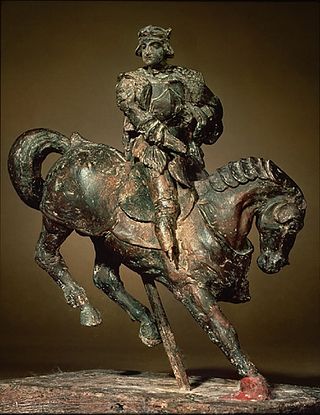
Horse and Rider is a beeswax sculpture depicting a rider on a horse. The history of the sculpture is unknown before the 20th century. The work has been attributed to Leonardo da Vinci by the Italian art historian Carlo Pedretti, though most historians have ignored or denied the attribution. A number of casts have been made, using a mold taken from the wax original.

Leonardo da Vinci's fighting vehicle also known as Da Vinci's Tank is one of the conceptions of the revered Italian polymath and artist Leonardo da Vinci.
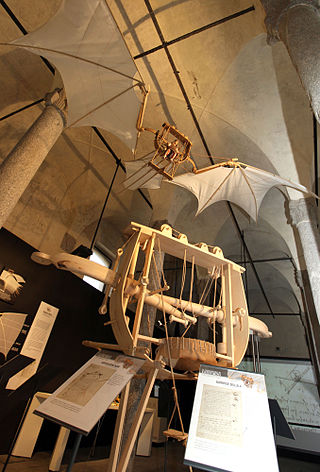
The Great Kite was a wooden machine designed by Leonardo da Vinci. Leonardo realized it between the end of the 15th Century and the beginning of the 16th Century. Drawings of parts and components of this machine can be found in the Codex on the flight of birds, which however lacks the overall description of the machine itself. Some drawings within the same codex suggest that it was created in similarity with flapping flight. However, this was hardly possible to perform given the available technologies, thus Leonardo developed a machine for mainly a gliding flight. The machine is named after the animal from which Leonardo took inspiration to realize the flying machine, the Kite.

Leonardo3 is an interactive museum and exhibition center at Galleria Vittorio Emanuele II, Piazza della Scala, Milano, Italy. The museum was inaugurated in 2013, and is devoted to Italy’s notable personality Leonardo da Vinci, who is portrayed both as an artist and inventor.

The Museo Leonardiano di Vinci, or Leonardian Museum of Vinci, is a museum dedicated to Leonardo da Vinci, located in Vinci, Leonardo's birthplace, in the province of Florence, Italy.